Vanuatu festivities (with photos)

JJMoon Diary
Barry and Margaret Wilmshurst
Wed 20 Aug 2008 06:43
|
The events at Lamen Bay, Epi were
very well done. By 0930 eight local young men were constructing
running sails from palm fronds on the beach. At 1000 they were sent
off in their canoes by a blast on a conch shell to race to Lamen Island two
miles away where they landed, lowered sail and paddled back. Each ran
through a triumphal floral arch on the beach to yachtie and local applause and
in due course all were presented with prizes by the chief amid further
acclamation. A good fish lunch was served from 1130 and those who
wanted exercise were taken on walks through the village.
Alternatively we could try our hands in a dug-out canoe. Mags and a friend
went round in circles but at least they stayed afloat, unlike one poor
chap. An excellent supper, including beer and red wine, completed the
day. We paid for the meals but the prices were reasonable. Our old
friend the yellow sea-plane from Port Vila turned up and was the centre of
attraction. The pilot was still pumping out his floats but, to be fair, it
is a very fine plane apparently in competent hands. School was let out for
the morning and Mags spent a most enjoyable and interesting hour chatting
to the teacher of the reception class.
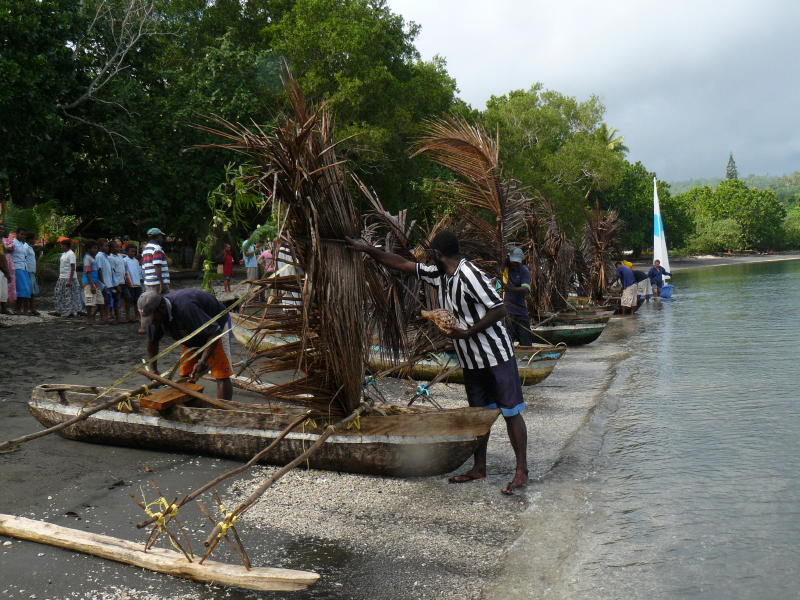 The starting
line.
The whole day was carried through
with some aplomb. The prizes were donated by a New Zealand yacht that is a
frequent visitor to Vanuatu waters. The crews from twenty-three boats
certainly enjoyed themselves and there was every indication that the locals did
too. This was the second year that the event had been staged and there was
talk of even bigger and better next year.
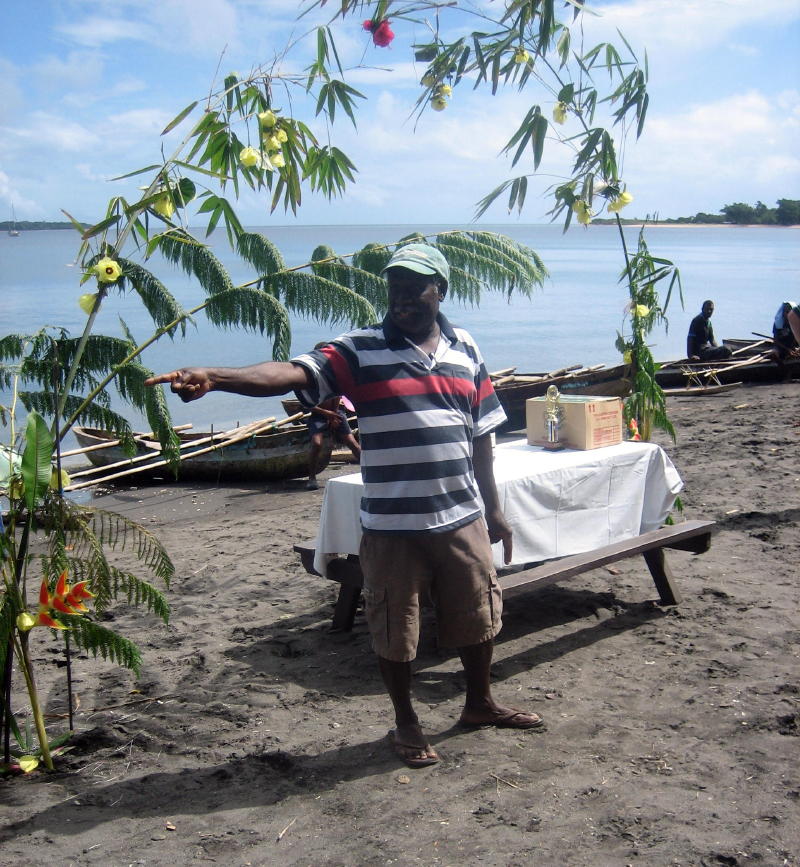 The chief of the village
giving a speech prior to presenting the prizes.
The festival at South-West Bay, Malakula
which started four days later was a good deal more ambitious. Three
villages round the bay had been encouraged to hold events on consecutive
days. These are "custom" villages, a frequently used term in these
parts, which I take to be shorthand for "traditional customs and all that
appertains to them". The people are nearly self-sufficient, living easily
off the abundance of the fruits of land and sea and with plenty of
clean water. As well as growing vegetables in a very fertile soil they
keep pigs, cattle, goats and chickens. Most transport is by dug-out
outrigger canoes but the modern world is making inroads. There are schools
(not everybody can afford the fees for secondary education), a telephone, a
communal television and a supply ship that calls once or twice a month serviced
by one or two larger boats with outboard motors.
On the first day the village wished to
open its new "yacht club" and offered entertainment in exchange for a good
turn-out. In this context "yacht club" means a larger than average hut
dedicated to the welcome of visiting yachties. The new premises are
approached a few hundred metres up a small fast flowing river and a walk to the
edge of the village. Musicians were tuneful and energetic, there was
serious ceremonial (in the American manner) in the raising of a new hand-made
club flag, ribbon cutting and speeches, including one by chief Tom.
He expressed the hope that greater tourist activity would encourage more young
people to remain in the village instead of sloping off to Port Vila. On
entering the club premises yachties presented gifts for the villagers and
ensigns and flags to be hung in the club. There were demonstrations of
canoe building, mat weaving, local cooking techniques, the many and varied
uses of the coconut and sand drawing. This latter exhibition was by a
native of the neighbouring island of Ambrym and was said to have mystical
connotations but I was not terribly impressed, finding it rather limited
and a bit sad. Lunch was provided free of charge and later in the
afternoon we climbed the hill behind the village to a small plateau to be
entertained by the musicians and by a group of ladies performing a custom
dance. Again, Mags in particular was made rather uncomfortable by
this. Before returning to our boats there was a guided tour of the lagoon
up the river to view the wild life. However, the Americans in their big
dinghies and large outboards careered off at great speed churning
up the placid waters and any bird or animal with any sense kept his head
down.
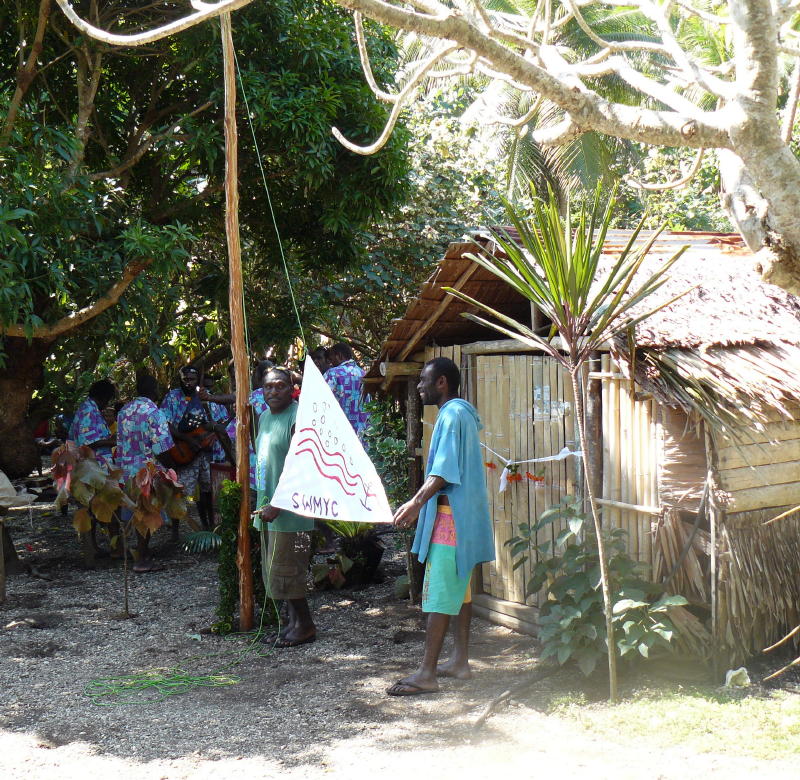 Raising the flag at the new
yacht club.
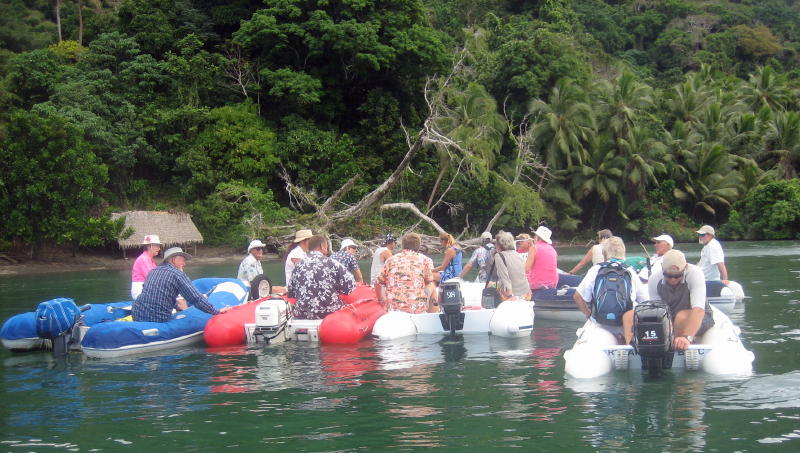 A trip round the lagoon
when there was some "showing off"!
The story behind the next day's
activities was a bit different. Last year a small cruise ship arranged to
call regularly at a village about a mile and a half away from the first and six
young men received some training from the tourism authority. The
grounds were prepared, seating arranged and custom dances rehearsed.
It went well on the occasions the ship called but this year the company
changed its itinerary and the villagers were left with new-found
skills but no-one to practice on. We did our best to make up the
deficiency. There were thirty-five boats in the bay and we paid 3000
vatus, about £16, per head. There were more demonstrations, two
custom dances from different tribes, lunch and an extensive guided tour of the
village and its environs. Each group of ten visitors was allocated a
local guide. Ours was Ricci, one of the lads who had been given some
training last year. One could not speak too highly of his courtesy,
general helpfulness and solicitude for an old white codger with a bit of a hip
problem. He is proud of his village and his way of life, scornful of those
who think they need mobile phones and spoke well about life in the village and
the way it was organised. He was rather less coherent when asked
about the aims and aspirations of the villagers in regard to tourism and
visiting yachts.
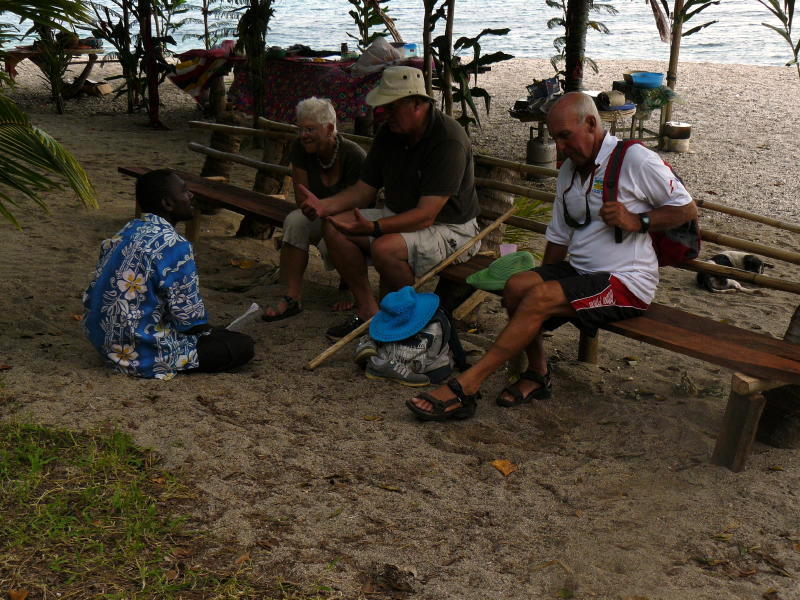 Our guide Ricci and Barry
with Jackie and Brian from Songster. Now who's instructing
whom?
On the third day another village
- said to be French speaking but as far as we could tell only the
chief speaks French - offered guided snorkeling over its impressive reef, a
light lunch and tours of the village. Some were a bit played out by this
time but Mags was one who enjoyed some good snorkeling. As before the
villagers welcomed their visitors with great courtesy. This
time they tucked a flower behind an ear of each visitor and offered a
coconut drink with a straw made from a local plant - much appreciated by those
of us who are not adept at pouring milk from a small hole in the shell straight
into the mouth.
There was a general feeling that we had
all enjoyed ourselves greatly over the three days and learnt a few things, but
what did it all mean? On a personal level we were enriched by
the brief insights into a culture so different from our own. But
what was to be gained by the villagers? They seemed to think their day had
been a success but the little "yacht club" is off the beaten track and not very
easy to locate. We were told that usually a few boats a month visit the
bay. Perhaps the word will get round and numbers will increase but will
this benefit anybody? One can readily see that with good advice, time and
investment the remoter parts of Vanuatu could become most attractive tourist
destinations but would anybody be better off?
Surely their way of life in the custom
villages is doomed - we get the impression there are changes every year.
At least some of the young people who have received a good secondary education
will want opportunities for creative work. If they go on to
university there will be few jobs for them in Vanuatu; very few in the
villages. But in some ways it seems a pity. The people are
apparently happy, healthy and well fed.
Following several chats with local
people Mags felt that there were things she could learn from the village
way of life. In particular she finds the relaxed style of living
with strong social groups and self entertainment very
appealing. The people have time to "stand and stare" - and
they live in some wonderfully beautiful places.
When thirty to forty boats have been
together for three or four days people always seem to start to get a bit
excitable. We were glad to move on to somewhere quieter. We
spent one night in the Maskelynes off the south-east corner of Malakula
Island, together with a dozen others who were going on to the custom festival on
Ambrym. Ambrym is one of two islands with an active volcano and the local
people are clearly still very influenced by its apparent power over their
lives. The annual festival and its Rom dances are famous. A
second night was spent, alone, in Waterfall Bay on Pentecost, an attractive
anchorage but exposed in strong winds and now we have been lying for a couple of
days at Asanvari at the south of Maewo. Here, chief Nelson has built a
very fine "yacht club" opened in 2002 but unfortunately we arrived at an
inopportune time. The Island Cruising Association rally, which left Opua
just before us, was here for a week recently and a great time was had by
all. This is now the club with no beer. Nor with anything
else except chief Nelson's excellent company for a chat. Oh, and
a copious waterfall just behind the beach where we took our washing to
be rinsed. The supply ship's
engine has broken down and the ship hasn't called for two
months.
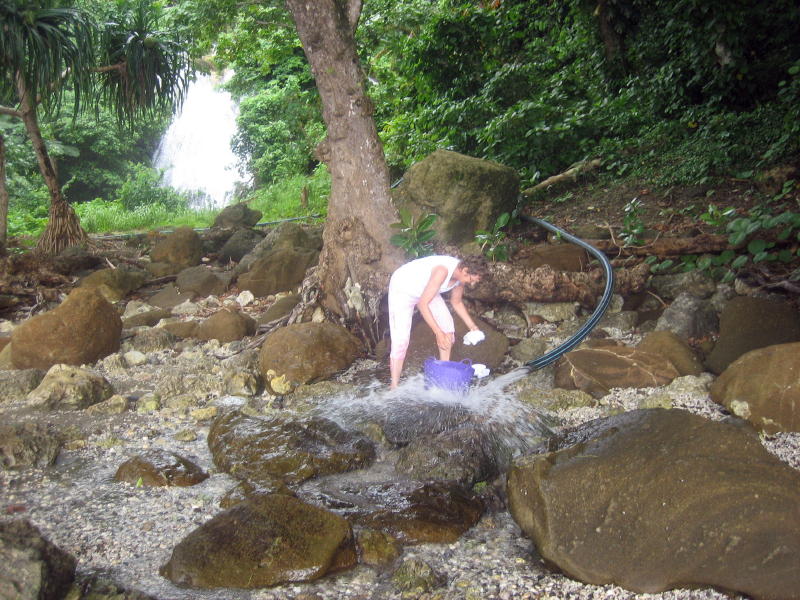 Mags rinsing the
washing at the waterfall laundry!
It has been raining hard off and on for
two days and we are running out of supplies ourselves. We plan to sail to
Luganville tomorrow with a commission to look out for any boat heading
for Asanvari with space available in a large freezer. The chief
wants 20 kilos of chicken wings. |